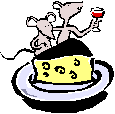 Making Food
Making Food
 Making Food
Making Food
Some of the food we eat would not be possible without the aid of bacteria – they carry out reactions that alter some foodstuffs in ways that may change their consistency (e.g. milk to cheese) or their flavour (e.g. chocolate). Some foods (e.g. ‘live’ yoghurt) even have added bacteria that are good to have in the stomach.
Cheese has been made for thousands of years – originally it was the action
of bacteria producing acid that caused the separation of a curd from the
milk. This curd was either used directly (for soft/cottage cheeses) or
compressed for hard cheeses. Modern methods may use rennin instead, either from cow stomachs or produced by genetically modified bacteria (vegetarian rennin).
The
coloured ‘veins’ in some cheeses are not bacteria but fungal spores
Chocolate is very important to many peoples hearts but it could not be made without bacteria. Bacteria and yeast act to develop the characteristic chocolate flavour from the cacao bean.
Yoghurt is made by the action of bacteria upon milk, fermenting the milk
sugar to lactic acid – as well as changing texture and taste this makes the
environment unsuitable for other, sometimes dangerous, bacteria. Other bacteria
may add different tastes
Nearly everyone has heard of the ‘friendly cultures’ in ‘bio’ yoghurt. Fewer know that these are live bacteria called bifidobacterium. These are normally found in the gut and it is thought by some that consuming them live is healthy. This opinion is not shared by all – some think that it is unlikely to make much difference.